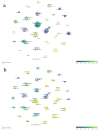Dental Caries and Salivary Oxidative Stress: Global Scientific Research Landscape
- PMID: 36829890
- PMCID: PMC9952432
- DOI: 10.3390/antiox12020330
Dental Caries and Salivary Oxidative Stress: Global Scientific Research Landscape
Abstract
This study aimed to analyze the research trends on salivary oxidative stress associated with dental caries and to perform bibliometric approaches for existing publications on this association. A search was performed using the Web of Science Core Collection, without any restriction of language or publication year. The number of periodicals with the most published articles in this theme, most published authors and keywords were mapped; other metrics were also evaluated such as the countries that have more research on the subject and the period in which there were more publications on the subject. During the knowledge mapping, the most frequent experimental designs were analyzed, type of saliva collection, stage of caries disease, evaluated oxidative parameters were retrieved and analyzed from each manuscript. Between the 43 selected articles, the Journal of Clinical Pediatric Dentistry was the periodical appearing the most with 4 published articles. The authors who published the most were Celec, P., Tothova, L., Hegde, A.M., Shetty, S., Antoniali, C., and Pessan, JP with three articles each, and a total of 180 keywords representing the evolution of the theme. India and Asia were found to be the country and continent with most publications, respectively. Most articles collected non-stimulated total saliva, with total antioxidant capacity being the parameter most often evaluated. The type of study that appeared the most was cross-sectional studies, and articles published in the period of 2017-2022 were the most frequent. Studies show that dental caries can be associated to the changes in salivary oxidative biochemistry with an increase in lipid peroxidation, a biomarker of oxidative damage, and an increase in antioxidant capacity in chronic caries, in response to cariogenic challenge. Some studies evidence the reduction of lipid peroxidation after treatment of the carious lesion. Our findings reveal worldwide research trends, as well as a clearer knowledge of the evolution and future scenarios of this issue, also showing the mechanisms associating dental caries with changes in salivary oxidative biochemical parameters are not clear.
Keywords: dental caries; oxidative stress; saliva.
Conflict of interest statement
The authors declare no conflict of interest.
Figures





Similar articles
-
Are Dental Caries Associated with Oxidative Stress in Saliva in Children and Adolescents? A Systematic Review.Metabolites. 2022 Sep 13;12(9):858. doi: 10.3390/metabo12090858. Metabolites. 2022. PMID: 36144263 Free PMC article. Review.
-
Effect of cerebral palsy and dental caries on dental plaque index, salivary parameters and oxidative stress in children and adolescents.Eur Arch Paediatr Dent. 2021 Feb;22(1):21-28. doi: 10.1007/s40368-020-00509-x. Epub 2020 Feb 1. Eur Arch Paediatr Dent. 2021. PMID: 32008171
-
Oxidative Stress and Salivary Physicochemical Characteristics Relative to Dental Caries and Restorative Treatment in Children.Antioxidants (Basel). 2025 Mar 28;14(4):405. doi: 10.3390/antiox14040405. Antioxidants (Basel). 2025. PMID: 40298617 Free PMC article.
-
Carious Lesion Severity Induces Higher Antioxidant System Activity and Consequently Reduces Oxidative Damage in Children's Saliva.Oxid Med Cell Longev. 2020 Jan 28;2020:3695683. doi: 10.1155/2020/3695683. eCollection 2020. Oxid Med Cell Longev. 2020. PMID: 32089767 Free PMC article.
-
Saliva as a biomarker for dental caries: A systematic review.J Conserv Dent. 2019 Jan-Feb;22(1):2-6. doi: 10.4103/JCD.JCD_531_18. J Conserv Dent. 2019. PMID: 30820074 Free PMC article. Review.
Cited by
-
What does scientometry tell us about mercury toxicology and its biological impairments?Heliyon. 2024 Mar 19;10(7):e27526. doi: 10.1016/j.heliyon.2024.e27526. eCollection 2024 Apr 15. Heliyon. 2024. PMID: 38586377 Free PMC article.
-
Quality-by-Design R&D of a Novel Nanozyme-Based Sensor for Saliva Antioxidant Capacity Evaluation.Antioxidants (Basel). 2023 May 18;12(5):1120. doi: 10.3390/antiox12051120. Antioxidants (Basel). 2023. PMID: 37237985 Free PMC article.
-
Nanotherapies Based on ROS Regulation in Oral Diseases.Adv Sci (Weinh). 2025 Mar;12(9):e2409087. doi: 10.1002/advs.202409087. Epub 2025 Jan 30. Adv Sci (Weinh). 2025. PMID: 39887942 Free PMC article. Review.
-
Assessment of Vitamin E and Glutathione Peroxidase Levels in Salivary Samples of Children With and Without Dental Caries in Erbil City, Iraq.Cureus. 2024 Nov 30;16(11):e74872. doi: 10.7759/cureus.74872. eCollection 2024 Nov. Cureus. 2024. PMID: 39741611 Free PMC article.
-
Investigation of the effects of benznidazole on the salivary glands: A biochemical, morphological, and functional approach.PLoS One. 2025 Jun 3;20(6):e0317876. doi: 10.1371/journal.pone.0317876. eCollection 2025. PLoS One. 2025. PMID: 40460136 Free PMC article.
References
-
- Pyati S.A., Naveen Kumar R., Kumar V., Praveen Kumar N.H., Reddy K.M.P. Salivary Flow Rate, pH, Buffering Capacity, Total Protein, Oxidative Stress and Antioxidant Capacity in Children with and without Dental Caries. J. Clin. Pediatr. Dent. 2018;42:445–449. doi: 10.17796/1053-4625-42.6.7. - DOI - PubMed
-
- Sheikhi M., Bouhafs R.K., Hammarström K.J., Jarstrand C. Lipid peroxidation caused by oxygen radicals from Fusobacterium-stimulated neutrophils as a possible model for the emergence of periodontitis. Oral Dis. 2001;7:41–46. - PubMed
-
- Baltacioglu E., Akalin F.A., Alver A., Balaban F., Unsal M., Karabulut E. Total antioxidant capacity and superoxide dismutase activity levels in serum and gingival crevicular fluid in post-menopausal women with chronic periodontitis. J. Clin. Periodontol. 2006;33:385–392. doi: 10.1111/j.1600-051X.2006.00923.x. - DOI - PubMed
Publication types
LinkOut - more resources
Full Text Sources

